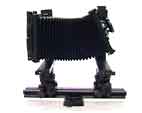What's Movements
| Normally the optical axis of the lens is perpendicular to the emulsion face of the film. Movements, which consists of rise, fall, shift, swing and tilt, are the mechanism that dislocates the front unit or the back unit to get a variety of creative effections on the picture. By this, the vertical relation between the optical axis of the lens and the emulsion face of the film is broken. Tilt and Swing break parallel relation between the front unit and the back unit, and Rise, Fall and Shift move either or both front unit or back unit still keeping paralle ralation between them. |
 |
Camera in the normal position. |
Move the front or back unit with keeping them parallel

 |
Rise / Fall
Rise is the state that the front unit is set higher along the arm than the back unit as the two are kept in parallel, and Fall is the front is set lower than the back in the same condition. |


View on the camera top. |
Shift
Shift is the state that the one of the units is moved either side horizontally. |
Move the front or back unit keeping them parallel

 |
Tilt
Tilt is the state that the one of the units is tilted up or down. |

 View on the camera top. |
Swing
Swing is the state that the one of the units is swung either side. It's called "front swing" when the front unit is swung, and "Back swing" when the back unit is. |
| Mediajoy HP (Japanese) | Back to Top | Camera Shopper |
| Copyright by 1996-2002(C)mediajoy All Rights Reserved. e-mail to mediajoy@mediajoy.co.jp |
||
